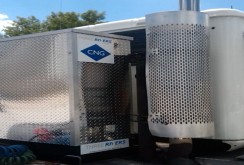
At a time when large corporations have had an unprecedented degree of power to impose themselves on the landscape in the name of jobs, a group of citizens, environmental activists, native tribes and businesses in the Pacific Northwest have dealt a series of stunning blows against development.
Since the 1990s, a group of large mining companies, railroads and maritime terminal operators have sought to use the Northwest’s Columbia River and Puget Sound waterways as a jumping-off point for rapidly expanded coal exports to China and other developing nations.
Under proposals from companies such as SSA Marine, Ambre Energy and Kinder Morgan, a total of six rail-accessed port facilities were proposed that would create thousands of construction and long-term operational jobs and generate millions of dollars in local tax revenues to help transport plentiful coal deposits from the Powder River Basin in Wyoming and Montana.
Citizens from the affected states, however, have thrown a wrench in these plans, convincing regulators to deny permits to four of the six proposals for environmental reasons. The most recent blow came on Aug. 18, when the Oregon Department of State Lands denied Ambre Energy’s permit request for a $242 million, 8 million-ton-per-day Coyote Island coal transfer facility at the Columbia River port of Morrow, Ore.
With the Oregon projects shut down, only the two largest terminal proposals are left on the drawing board: 1) the 48 million-ton-per-day Gateway Pacific Terminal at Cherry Point, Wash., and 2) the 44 million-ton-per-day Millennium Bulk Terminal in Longview, Wash.
According to Power Past Coal, one of the leading nonprofit coalitions opposing the plans, the Washington state proposals would increase rail traffic significantly, with up to 18 extra trains per day rolling through coastal towns, tying up car traffic for hours for the hundreds of towns with at-grade crossings. The added trains also raise a greater risk of derailments near population areas.
The environmental impacts, however, would be much greater, the group says. The open-air coal cars that would be used in these long trains emit about 500 pounds of coal dust per car into the skies along the route. More dust would also be released near the terminal sites as the coal is dumped in giant piles and loaded onto ships at new cargo piers that would need to be built.
The chosen locations for the rail terminals are hardly pristine wilderness; the Cherry Point site already has 225,000-barrel-per-day Phillips 66 oil refinery, and the Longview proposal is on the site of a former aluminum smelter. But Power Past Coal argues that the buffer zone of forest land surrounding the Cherry Point terminal, adjacent to the Lummi Indian Reservation, is still rich with both cultural heritage and intertidal species that help support local salmon runs.
“These trains would decimate tribal fishing,” said Kate Blystone, project manager of RE Source for Sustainable Communities, a nonprofit environmental group that also is opposed to the coal trains. “Whatever you build [at Cherry Point], you will be destroying habitat. More than 400 ships a year would be added to the maritime traffic, which already has to navigate some pretty dicey waters.”
RE Source was one of the first groups to protest the rail proposals. Through effective awareness campaigns, they were able to alert businesses and concerned citizens to various hearings that were held regarding the environmental impact statement (EIS) for the projects. “Scoping for an EIS is a pretty dull process, so it doesn’t get a very high turnout at the public hearings,” Blystone said. “But for the Cherry Point project, there were 125,000 comments from the community.”
While no one from Power Past Coal or RE Source is celebrating just yet, following their Oregon victories, momentum appears to be shifting in their favor.
“[Morrow] was the first decision that was made on a proposed coal terminal and it was ‘no,’” Blystone said. “It’s not over yet, but it shows that we are winning.”
So far, more than 100 organizations, 55 municipalities, 600 healthcare professionals, 500 local businesses and 160 elected officials have expressed concern or opposition to the remaining proposals. “Coal is not our future, it’s our past,” Blystone added.
Currently, SSA Marine is in the process of submitting an alternate site plan for the Cherry Point terminal that would accelerate the timetable to create an operational facility by 2017. This permitting schedule is seven years sooner than anticipated, which has given opposition groups a renewed sense of urgency.
“Once the draft EIS comes out, we will have a very short time period to make comments,” Blystone said. “So for the next 13 months, [RE Source] will continue building awareness about the project.”










